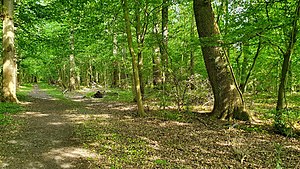Glüsinger Bruch and Osterbruch
|
Glüsinger Bruch and Osterbruch
|
||
| location | East of Tostedt , Harburg district , Lower Saxony | |
| surface | 169 hectares | |
| Identifier | NSG LÜ 355 | |
| WDPA ID | 555690897 | |
| Geographical location | 53 ° 16 ' N , 9 ° 45' E | |
|
|
||
| Sea level | from 40 m to 72 m | |
| Setup date | 1st December 2018 | |
The Glüsinger Bruch and Osterbruch is a nature reserve in the Lower Saxon communities of Tostedt and Welle in the Tostedt municipality in the Harburg district .
The nature reserve with the sign NSG LÜ 355 is approximately 169 hectares . The largest part is part of the FFH area "Este, Bötersheimer Heide, Glüsinger Bruch and Osterbruch". The area has been under nature protection since December 1, 2018. The responsible lower nature conservation authority is the district of Harburg.
The nature reserve is located directly east of Tostedt in a valley west of the Esteaue . It includes parts of the Glüsinger Bruch and the Osterbruch as well as the lowland of the Langeloher Bach, which flows from the Osterbruch to the Este, up to the road crossing at Langeloh. In the nature reserve, damp deciduous forests grow thick with open land areas that are embedded in or adjacent to them, predominantly as wet grassland . The deciduous forests are formed by oak-hornbeam , mixed oak, alder-ash and alder swamp forests . The dominant tree species are common oak , black alder and common ash . The oak-hornbeam forests have a well-developed shrub layer and a. with hazel and hawthorn. The herb layer is u. a. formed by woodruff and wood anemone. In the herbaceous layer of the quarry forests are u. a. Marsh Pinnau , hairgrass , Winkelsegge , meadowsweet, Goldhahnenfuß , Gundermann and nettle to find. In some places beech forests with holly are formed in the undergrowth . The forests have a high proportion of old and dead wood and well-defined forest edges . The green forest hyacinth , which is endangered in Lower Saxony, also settles in the nature reserve .
In the north of the Osterbruch there are two ponds with aquatic plants in the nature reserve, which are used as fish ponds . Several streams arise in the east of the nature reserve. Moist tall herbaceous vegetation , reed beds and sedge beds are formed at the edges of water bodies and on fallow grassland . The grasslands in the nature reserve are extensively managed as hay meadows .
The nature reserve is a habitat and a. various birds , bats , reptiles and amphibians . The woodpeckers middle woodpecker , small woodpecker and gray woodpecker as well as the bats Bechstein's bat , great noctule bat and pug bat are native here. Reptiles are z. B. represented by the forest lizard , amphibians by the crested newt . The meadow areas are habitat u. a. of meadow pipit , yellow wagtail and whinchat . The nature reserve is also home to various insects , including dragonflies and butterflies . Large mussels and bitterling can be found in the ponds . The nature reserve is also a habitat for black stork , honey buzzard and red kite . The area is a potential habitat for the otter .
Web links
- Nature reserve "Glüsinger Bruch and Osterbruch" in the database of the Lower Saxony State Office for Water Management, Coastal and Nature Conservation (NLWKN)
- Nature reserve "Glüsinger Bruch and Osterbruch" , Harburg district
Individual evidence
- ↑ Natura 2000 in the Harburg district, Harburg district. Retrieved January 21, 2019.
- ↑ a b Glüsinger Bruch / Osterbruch. In: Notifications of the AKN , special issue No. 1, Natura 2000, working group for nature conservation in the Samtgemeinde Tostedt e. V. Accessed January 21, 2019.




